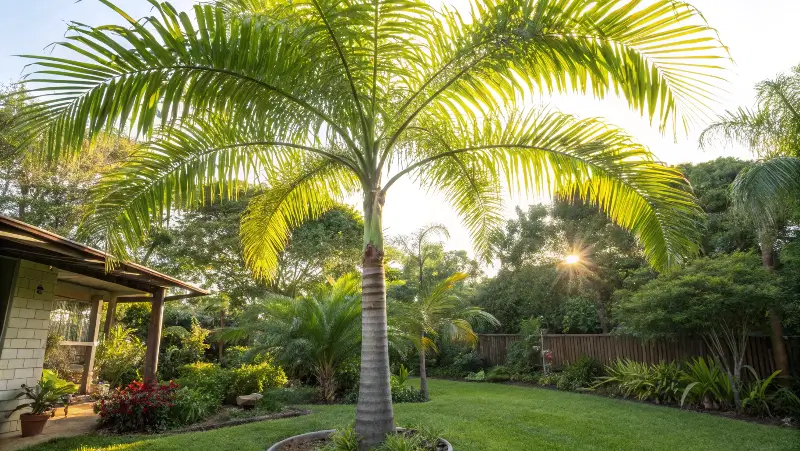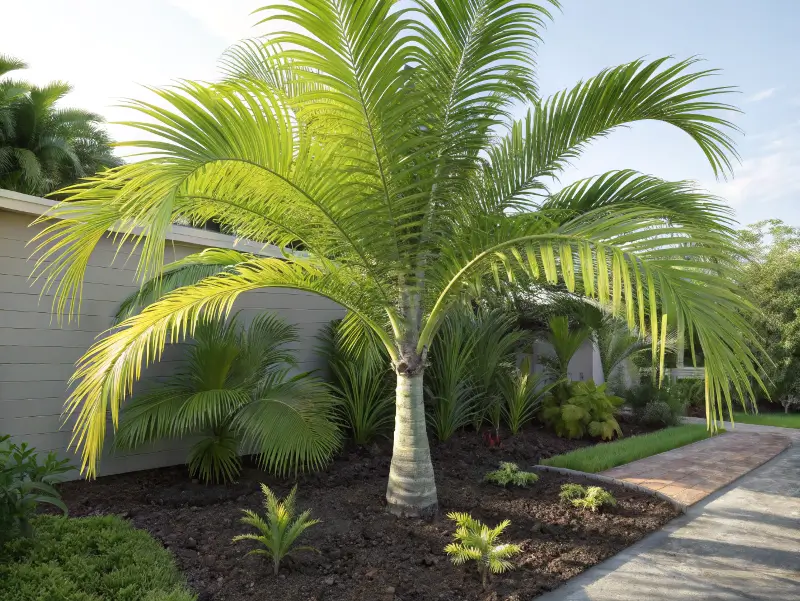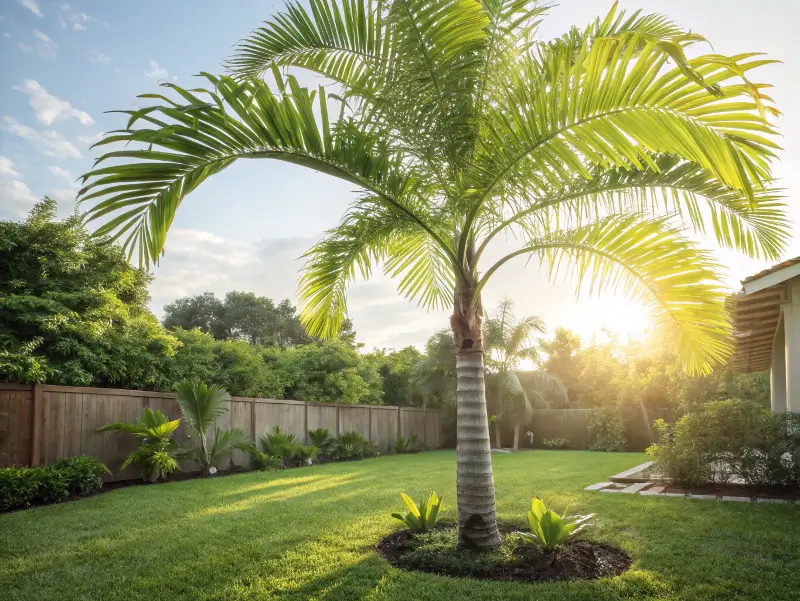
So, you’ve discovered the king palm tree and want to learn more? Excellent! In this piece, I’ll walk you through simple planting tips, stress-free maintenance, and ways to handle pesky pests. I adore the king palm tree for its refreshing tropical vibe, perfect for any yard. You’ll get clever landscaping ideas, quick comparisons to other palms, and helpful advice to avoid nutrient and watering woes. Let’s officially get started now!
Table of Contents
Introduction
What Is the King Palm Tree?
I’ve always been blown away by the look of the king palm tree. Technically called Archontophoenix cunninghamiana, this beauty is sometimes called the Bangalow Palm in certain places. If you’re on social media, you might see folks rave about its feather palm fronds and sleek trunk ring.
- It’s a well-known ornamental palm species.
- You’ll often spot it in subtropical environments where it thrives.
- It’s valued for low-maintenance palm care when root systems, soil, and watering are managed well.
I’m personally a huge fan of how it lifts the mood in any yard—seriously, the king palm tree can transform a cramped space into a mini oasis. Just imagine stepping outside and feeling a cool breeze dance through those graceful fronds. So dreamy.
Why People Love King Palm Trees
I think part of the hype comes from their moderate size, which fits in many landscaping styles with palms. They add a tropical garden design vibe that works well for both casual and formal looks. Plus, you can plant multiple king palm trees in clusters for a bolder statement.
King Palm Tree Species and Varieties
Archontophoenix Cunninghamiana and Relatives
The king palm tree family, known as Archontophoenix, includes a few sibling species. But Archontophoenix cunninghamiana stands out for its consistent green crown shaft and relatively slim trunk.
- Crown shaft often looks bright green, making the trunk look neat.
- Perfect for container-grown palm setups, especially in smaller yards.
- Works well in outdoor palm cultivation with the right watering schedule.
I’ve noticed some folks mistake it for other subtropical palms, like the Foxtail or Majesty, but those have different frond shapes and trunk details.
A Quick Look at Foxtail, Majesty, and Queen Palms
- Foxtail Palm: Fluffy fronds that give a bushier look.
- Majesty Palm: Enjoys water, but can be fussy about consistent moisture.
- Queen Palm: Often taller, with arching fronds that droop at the tips.
Though each has a certain charm, I feel the king palm tree is the easiest one to handle if you’re new to tropical landscaping.
Ideal Growing Conditions for the King Palm Tree

Climate Requirements (Sunlight vs. Shade)
The king palm tree loves mild to bright sunlight. Yet, intense afternoon rays in scorching climates can stress the leaves.
- Consider partial shade if your region gets blazing summer suns.
- Ensure plenty of morning light for stronger frond development.
- Keep in mind heat and humidity tolerance is decent, but direct, relentless sunlight may cause foliage discoloration.
I tend to plant them in spots that get gentle morning rays, followed by a little afternoon break. Let’s face it: nobody likes to roast all day, including palms.
Soil and Watering Guidelines
Good soil is everything. I always recommend a mix that drains well but retains some moisture.
- Add organic matter or compost for extra nutrients.
- Check that the pH isn’t too acidic or too alkaline.
- Rely on palm drip irrigation or a soaker hose if you want to be water-wise.
Overwatering is a big no-no, because a soggy palm root system can lead to rot. Let the top inch or two of soil dry before your next watering spree.
Planting and Maintenance Tips
Best Practices for Planting King Palm Seeds or Seedlings
When I started my first king palm tree from seed, I had to remind myself to chill—it can take weeks or even months for those seeds to sprout. However, you can speed things up by keeping the seeds in a moist, slightly warm place. If you’re going for seedlings:
- Dig a hole about twice the size of the root ball.
- Fill in with a loose, rich soil blend.
- Water thoroughly but avoid waterlogging.
If you’re a do-it-yourself palm planting type, just make sure you give them enough space so their roots don’t get cramped.
Fertilization Schedule and Soil Amendments
I usually feed my king palm tree with a balanced palm tree fertilizer about three times during the growing season.
- Aim for the best palm fertilizer ratio with micronutrients like manganese and magnesium.
- Add compost to boost organic content.
- Go easy on heavy synthetic feeds to avoid chemical burn.
This routine, combined with the right watering approach, keeps my king palm tree looking fresh and lively.
Pruning and Care Routines

Proper Techniques for Trimming Fronds
Pruning palm fronds always makes me a little anxious, but it’s actually pretty simple. Cut only the dead or yellow leaves, and don’t chop off healthy green fronds.
- Use sharp, disinfected tools.
- Trim close to the base of the frond—avoid damaging the trunk ring.
- Snip off any loose hanging bits that might harbor pests.
This helps your king palm tree direct its energy to the healthy fronds while keeping the trunk visually clean.
Routine Inspection for Pests and Diseases
Let’s face it, pests sometimes love these attractive palms. Check your king palm tree for common intruders like:
- Scale, which appears as tiny bumps along the fronds.
- Spider mites, which spin fine webs under leaves.
- Mealybugs, often in white, cottony clusters.
Try insecticidal soap or horticultural oil at the first sign of trouble. Also, watch for fungus on the crown shaft—constant moisture can invite problems. Checking weekly can spare you bigger headaches later.
Landscaping with King Palm Trees
King Palms for Residential Gardens
I’m a big-time fan of using king palm trees in everyday yard designs. They bring that breezy, easygoing resort vibe without hogging too much space.
- Great near patios or decks for partial shade.
- Pairs well with smaller shrubs for layered privacy.
- Looks amazing near water features like small ponds.
If you’ve got a chunk of yard that feels plain, inserting a few king palm trees can instantly make it feel more inviting. In fact, combining them with a fun plant like Travelers Palm can dial up the tropical look big-time.
Using King Palm Trees in Commercial and Urban Settings
Commercial spaces often favor a king palm because of its tidy, modern silhouette.
- Malls and business parks install clusters for a lush effect.
- Container-grown palm options allow them to thrive even in tight spaces.
- They handle partial indoor-outdoor transitions if the area has enough light.
Just remember to keep feeding and watering consistent—city environments can be tricky for palms if air is dry or pollution is high.
Comparing King Palm with Other Popular Palms
King vs. Royal Palm
When deciding between a king palm tree and a Royal Palm, note that Royal Palms can reach huge heights with a thick trunk. While they look dramatic, they often crave constant moisture. By contrast, the king palm tree is a bit easier on new growers, in my opinion.
- Royal Palms might overshadow small yards.
- King palm trees rarely outgrow modest spaces.
- Royal Palms feature a bulging trunk, while king palm trees stay sleek.
I think the king palm tree is more user-friendly if you’re just starting out or have limited yard space.
King vs. Queen Palm Tree
The queen palm tree is another popular pick, known for arching fronds that droop elegantly. Meanwhile, the king palm has a more upright stance.
- Queen Palm: Slender trunk, tolerant of partial shade, but can get leggy if neglected.
- King Palm: Smoother trunk ring, consistently upright crown shaft, less droop.
I find the king palm simpler to maintain, though queens are also quite lovely. By the way, you can pair them with a Sylvester Palm Tree for extra variety in trunk textures if you want a truly interesting lineup.
Common Challenges and How to Overcome Them

Dealing with Pests and Diseases
I’ve had my share of battles with pests on my king palm. However, a little diligence goes a long way:
- Treat scale or mealybugs early with mild soapy sprays.
- Check the crown shaft for fungus if you notice funky smells or brown spots.
- Remove heavily infested fronds if needed.
Also, keep an eye out for palm bud rot in extremely wet conditions. Proper air circulation and moderate watering can reduce fungal threats.
Troubleshooting Poor Growth or Discoloration
Sometimes you notice a frond droop or random yellow leaves on a king palm tree. That might hint at a nutrient shortfall.
- Check for magnesium or manganese deficiency.
- Apply a balanced palm fertilizer or specialized soil amendments.
- Make sure the root zone isn’t in standing water.
I’ve saved a few droopy palms by improving drainage, especially if heavy clay in the yard traps water. In other words, let that soil breathe so your king palm tree can flourish.
King Palm Trees in Eco-Conscious Landscaping
Reducing Water Usage and Environmental Impact
I’m all about sustainable palm gardening. If you aim to be water-smart, try:
- Mulching around your palm’s base to lock in moisture.
- Installing a drip line or soaker hose.
- Watering in the early morning to reduce evaporation.
I feel like these steps help you cut down on unnecessary waste and keep your king palm tree well-hydrated. Meanwhile, you can also pair it with other drought-tolerant plants in your yard for a balanced, green-friendly approach.
Creating a Wildlife-Friendly Habitat
A king palm tree can enhance biodiversity in your garden. Birds sometimes nest among the fronds, and beneficial insects may visit if you keep chemicals to a minimum.
- Space out multiple king palm trees so local critters can move freely.
- Plant pollinator-friendly flowers near the base.
- Use slow-release, organic fertilizers to limit chemical runoff.
Should you want more tips on how to handle local climate zones for your palm, I suggest reviewing the USDA Plant Hardiness info to pick the best times for planting and feeding. It’s always good to stay in tune with your region’s specifics.
FAQs
How Big Do King Palm Trees Get?
In the right setting, a king palm can shoot up to around 40 feet high. Some folks have even reported them edging closer to 50 feet if conditions are extra favorable. I’d say that’s tall enough to provide that coveted shade and towering presence without turning your yard into a jungle.
What Is the Difference Between King and Queen Palm Trees?
They’re similar in a few ways, but the queen palm tree generally has droopier fronds and a skinnier trunk. Meanwhile, a king palm stands proud with upright, feather palm fronds and a slightly thicker trunk. Honestly, it’s a matter of style preference—both are visually striking.
Do King Palm Trees Like Sun or Shade?
I’ve grown them in both. However, partial sun (especially during harsh afternoons) is ideal for preventing burned fronds. They do well in bright conditions overall, as long as they’re not fried by intense heat all day long.
Are King Palms Hard to Grow?
Nah. If you follow some simple guidelines—like picking good soil, giving moderate watering, and providing the best palm fertilizer ratio—your king palm should settle in just fine. That’s why they’re often recommended for new palm enthusiasts.
Final Thoughts
I hope this conversation about the king palm has sparked some fresh enthusiasm for your yard. Whether you’re just daydreaming of a tropical garden design or you plan to add a few king palm trees next week, these palms can fit into a huge variety of landscapes. With partial shade, balanced fertilizer, and routine pruning of dead fronds, you’ll see them show off their vivid color and upright fronds. I honestly love relaxing under mine, sipping on a cold drink—especially in the warm months of spring.
If you tackle pests early, maintain a reliable watering schedule, and watch for nutrient gaps, you’ll probably avoid major headaches. You can even place a king palm beside a pond or near a pool to add some breezy resort vibes to your place. Go ahead and have fun combining them with other tropical plants, like the Travelers Palm, or even the Sylvester Palm Tree for visual contrast. Trust me, you’ll be grinning every time you walk into your backyard.
